As the group stage gives way to knockout games in Qatar, PKs will inevitably become a factor. For those who prepare accordingly, there are proven ways to gain an edge.
The penalty kick is soccer in its purest form: a ball, a goal, a kicker and a goalkeeper. You’d think that any player talented enough to represent their national team would be able to score from 12 yards. And yet, competing in a World Cup penalty shootout is as emotionally fraught a task an athlete can be asked to perform.
The shootout’s unique place in sporting drama dates back to its first instance in the tournament, the 1982 semifinal between France and West Germany (it is used to settle matches from the knockout round of 16 on). At the end of a rugged 90 minutes—plus 30 more of extra time—the goalkeepers, inexperienced in shootouts, seemed rooted to the goal line, often diving after the ball had passed them. The first player to miss in the five-round contest, German midfielder Uli Stielike, reacted by curling into a ball on the ground and then bursting into tears as he made his way back to the center circle. For the millions watching around the world, the implication was clear: Missing a penalty was a terrible fate, capable of reducing powerful professional athletes into blubbering, infantile wrecks. Penalties were scary—and we, the audience, were hooked.
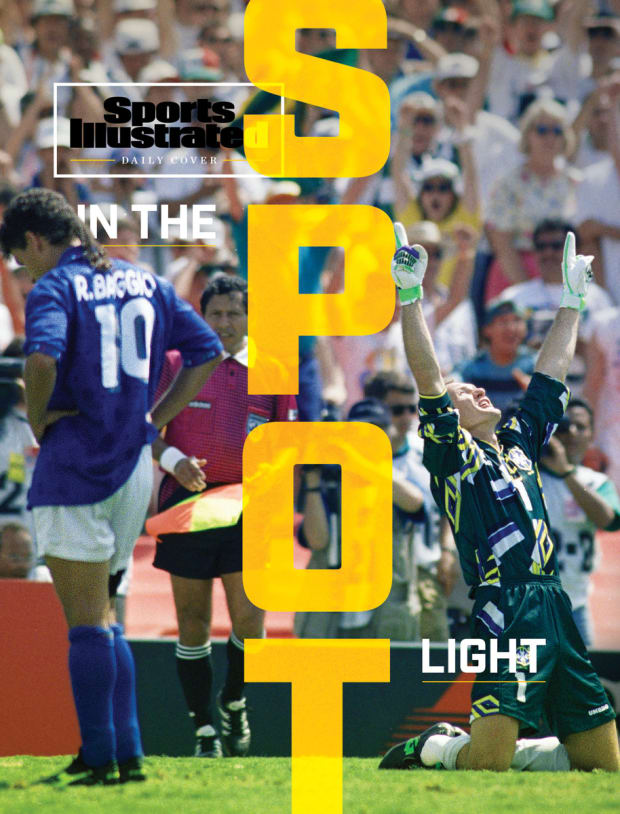
Shaun Botterill/Allsport/Getty Images
No one was immune to missing. In 1994, Italy’s Roberto Baggio was the world’s best player, whose goals in the quarterfinals and semifinals had earned his team a place in the final against Brazil. After a goalless draw, in the sweltering heat of the Rose Bowl, Baggio stepped up to take his kick for Italy in the first World Cup final shootout. Brazil led the PKs 3–2; Baggio needed a goal to avoid defeat. His penalty record was impressive: He ended his career with a success rate of 88%, well above the 78% average. “We were all feeling the same before the penalties,” he remembers. “We could see the fear in each other’s eyes.” Baggio fired his penalty over the crossbar, and Italy lost.
Baggio is not alone in this fate. The list of players to miss World Cup shootout penalties includes the game’s greats: Sócrates, Michel Platini, Andriy Shevchenko and Diego Maradona among them. And alongside these world-class players, you can include English players—lots of them.
England, you see, has the worst record of any men’s national team in shootouts. It lost seven of its first eight in the World Cup or European Championships, each one bringing a fresh national trauma. As an English football fan, I watched as coach Roy Hodgson shrugged off his team’s 2012 Euros elimination to Italy via shootout (this was loss No. 7) by describing it as a game of chance and saying that you can never prepare. He was repeating what all losing England coaches had said before. I thought he was wrong.

Two years earlier, I had been four minutes away from helping to determine the outcome of a World Cup final. It was 2010, and I was part of a team, along with Soccernomics authors Simon Kuper and Stefan Szymanski, and London School of Economics professor Ignacio Palacios-Huerta, that put together a dossier on penalty kicks for the Netherlands ahead of the final against Spain in South Africa.
This was before the data revolution in soccer, and there was no doubt that the information provided—containing penalty preferences and kicking trends for the likes of Fernando Torres and David Villa—would have given the Netherlands an edge if the game went to a shootout. The Dutch seemed so confident, in fact, that they appeared to spend most of the match playing for penalties. Four minutes from the end of extra time, though, Andrés Iniesta scored Spain’s winning goal. We will never know whether Villa would have kicked to the goalkeeper’s left, as the report predicted.
And so, after Hodgson’s depressing verdict, I began investigating whether there were ways to improve a team’s chances in a penalty shootout, spending the next two years traveling the world seeking to unravel the mystery of the perfect penalty kick. I spoke to players who had scored penalties and missed penalties; to a player from every team that had beaten England on penalties. I spoke to goalkeepers and coaches, doctors and psychologists. I even spoke to golfers, tennis players, rugby kickers and gridiron coaches, all of whom practice specifically for high-pressure moments.
The outcome of this investigation was published in my book Twelve Yards: The Art and Psychology of the Perfect Penalty. I came away with a few key learnings. First, everyone loves a penalty shootout (except the players who lose them) and also that, yes, there are ways to boost your chances of winning one. The penalty kick is a trainable skill that can be improved (proving a succession of English coaches wrong), and, when it comes to penalties, ability takes a back seat to psychology.
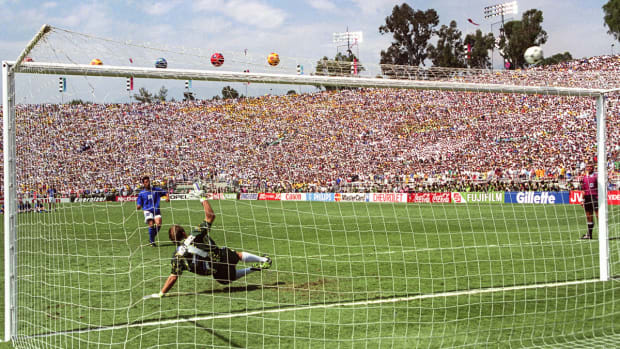
Neal Simpson/EMPICS/Getty Images
Let’s go back to Baggio’s missed penalty from 1994. Baggio’s shot backs up two of the most interesting findings from the research of Norwegian sport psychologist Dr. Geir Jordet. One, that players of “high status” (those who have won individual awards), who face increased pressure due to higher expectations, have lower penalty conversion rates; and two, that penalty kicks to avoid defeat in a World Cup shootout are much harder to score, with a conversion rate of 62%, as opposed to 92% when kicking to win the shootout. “This shows how big the differences are when you put psychology into the mix,” says Jordet. “It basically shows the power of thinking about positive, rather than negative, consequences.”
This might have been the reason for one of England’s most famous shootout disasters, in the 2006 World Cup against Portugal. Even after Wayne Rooney was sent off early in the second half, Portugal was still happy to play for PKs. Sure enough, England had three out of four penalties saved and lost the shootout 3–1.
“These big players miss, and that’s not because they are the wrong players to take penalties,” says Ricardo Soares Pereira, who was Portugal’s goalkeeper in that game and now works with youth goalkeepers in the national setup. “These players are at the best clubs in the world, but in these big games, it becomes a mental thing. They need to do some mental work.”
The question is, what does this mental work look like? Didier Deschamps, coach of 2018 world champion France, says he never has his players practice penalties, because he trusts them to get the job done. That didn’t look so smart at Euro 2020, when his star player, Kylian Mbappé, missed his kick to avoid defeat against Switzerland. Other coaches remain unconvinced that you can replicate the pressure of a World Cup shootout. But try telling Novak Djokovic not to practice his second serve in training because it’s not the same as a match, or asking Scottie Scheffler to pack away his putter, as there’s no pressure in practice.
The key to training players for the shootout is the word purpose. What does purposeful practice look like? In the case of former South Korea coach Guus Hiddink, it involved having his players walk from one penalty spot to the other in an empty stadium on the day before their 2002 World Cup quarterfinal against Spain. Hiddink was training his players to be ready for the (shorter, but more tense) walk from center to the spot in the match. It went to penalties, and South Korea won 5–3.
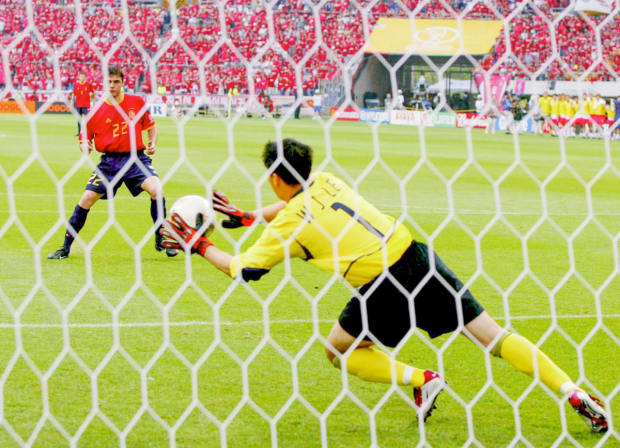
Andreas Rentz/Bongarts/Getty Images
Before the 2018 World Cup, England also put purpose into its practice. The shootout training began years before the tournament (to normalize the process) and was so advanced that by the time the World Cup began, each player knew whether he would be taking a penalty, what number in the order his penalty would be and, crucially, where he would be directing his penalty. In pressure situations, our decision-making faculties falter, so the coaches wanted decisions made in advance.
England also focused heavily on its players’ body language. When midfielder Jordan Henderson was the first to miss a penalty in the inevitable shootout in the round of 16 against Colombia, he did not physically crumble like Stielike. Instead, he walked back to his teammates with his head held high. England goalkeeper Jordan Pickford was the first player to hand the ball to his own team’s penalty taker, giving him a friendly start to his pre-kick routine. England went on to win that shootout and break a World Cup penalty hex that had lasted 28 years.
Its coach, Gareth Southgate, knew that history better than most. His penalty miss in the 1996 European Championship semifinal against Germany had started the national trauma in the first place, and he was determined to avoid anyone being as unprepared as he was then.
And yes, even preparing for a shootout does not guarantee success. After England lost the Euro 2020 final to Italy on penalties, Southgate did not blame the defeat on misfortune, but took responsibility. “I chose the guys to take the kicks ... and nobody is on their own,” he said.
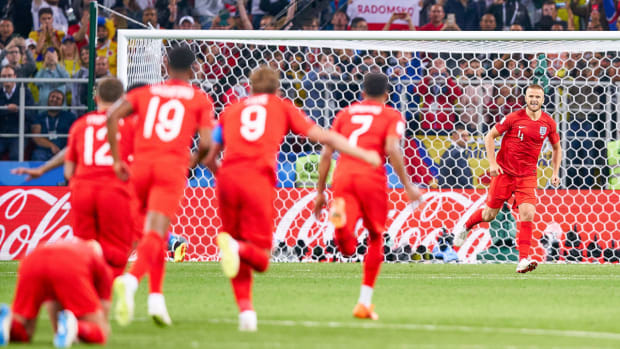
Simon Stacpool/Offside/Getty Images
So, what can we expect at the 2022 World Cup? One, a reminder from the more progressive coaches that penalties are a trainable skill. And two, an increasing focus on psychology—for that, in most cases, watch the goalkeeper.
Examples of keepers working opponents’ minds are plentiful: There’s Argentina’s trash-talking Emiliano Martínez, who told Colombian kicker Yerry Mina that he knew exactly where he was going to kick it—and then made the save—on the way to winning the 2021 Copa América. There’s Brest’s Gautier Larsonneur, of France, who stood off to the right of his goal to psyche out Neymar in a 2021 Ligue 1 match, with the Brazilian star missing the target entirely. There’s Atlético Mineiro’s Everson, from Brazil, who takes time placing a prayer necklace in the goal before every penalty. And then, with a direct link to the 2022 World Cup, there is Andrew Redmayne.
With Australia and Peru locked in a scoreless draw to determine which nation would land the final spot in Qatar, Redmayne was subbed in to play goal in the final minutes of extra time. Redmayne is not a penalty expert, but that didn’t matter, because his mere presence as a substitute appeared to sow doubt in the mind of the takers. Redmayne elaborately and unpredictably danced across his goal line before every penalty. He threw his counterpart’s water bottle, which contained information on the Australian kickers’ preferences, into the stands. And with Peru facing a make-or-go-home final kick, he took so long to get into position that Alex Valera had to wait an absurd 18 seconds after spotting the ball to take his penalty, which Redmayne saved, winning the match for Australia. Jordet’s research shows that goalkeeper distraction techniques are linked with 10% fewer penalty conversions, and long waits can reduce conversion by 20%.
“Football today is a psychological game,” Jordet explains. “Mind games have evolved: On one hand, they’re more intense and brutal, on the other, they are more subtle and complex. [In the case of Australia,] Redmayne deliberately seized control over this shootout.”
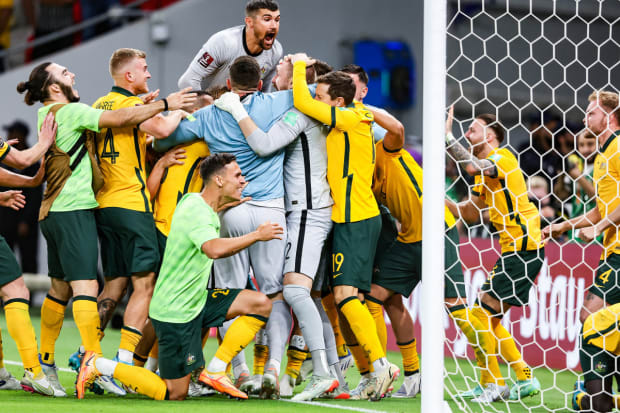
Matthew Ashton/AMA/Getty Images
These mind games are not just limited to goalkeepers. We might see other players scuffing up a penalty spot, turning their backs on the keeper to avoid their antics and moving to the front of the center circle to show support for the kicker.
Purposeful practice and a focus on psychology do not guarantee success in the shootout, but they will improve a team’s chances. The other research finding that could haunt some teams is that losing shootouts is a contagious habit—and so is winning them. A player’s likelihood of converting a penalty if their team won its last shootout rises from 76% to 83% (and 89% if the team won its last two shootouts). If the team lost, it drops to 72% (and 57% if two in a row). That’s bad news for Ghana, which has lost its last five shootouts, and for Spain, which has been eliminated from its last two tournaments on spot kicks. It’s better news for Croatia, which won successive shootouts in 2018.
Where this leaves the U.S. men’s national team is anyone’s guess. In the last 17 years, it has taken part in only one shootout, losing 3–2 in a barely significant 2015 Concacaf Gold Cup third-place match against Panama. In fact, no team has played more World Cup matches without facing a shootout than the USMNT. There’s a real need for worry, though, only if coach Gregg Berhalter says you cannot prepare for the chance of a shootout.
In 2014, Netherlands coach Louis van Gaal could not wait to claim credit for his club’s World Cup quarterfinal shootout victory. He had subbed on goalkeeper Tim Krul for the penalties, just like Australia would do eight years later. van Gaal’s tactic psyched out Costa Rica and resulted in a rare Dutch shootout success. A few days later, his team lost to Argentina on penalties. van Gaal’s reaction was priceless—if not misinformed.
“Ach, the penalty shootout, it’s just a lottery.”